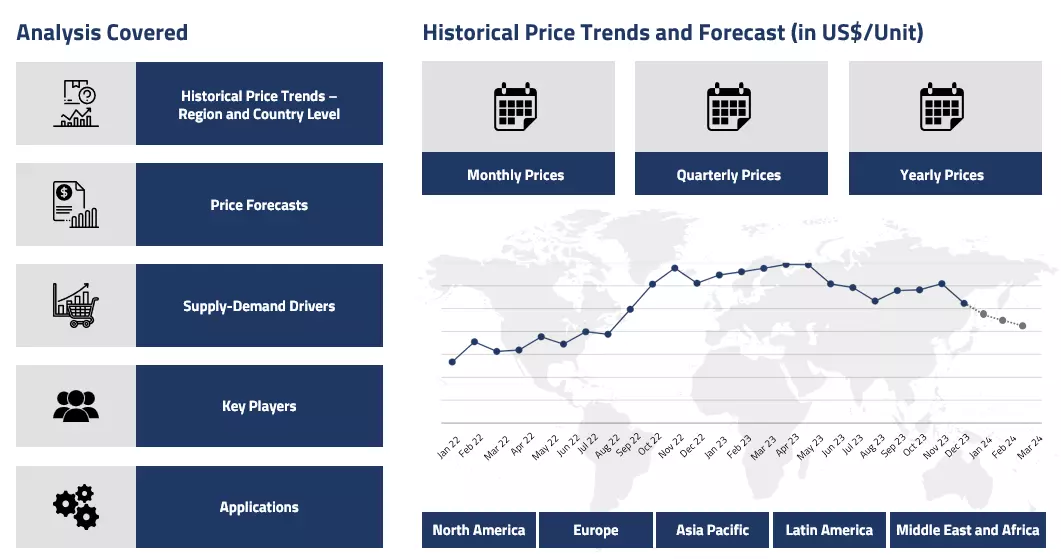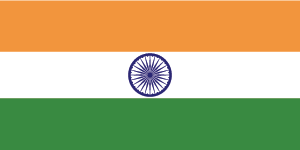Product
Barley Price Trend and Forecast
Barley Price Trend and Forecast
Barley Regional Price Overview
Get the latest insights on price movement and trend analysis of Barley in different regions across the world (Asia, Europe, North America, Latin America, and the Middle East & Africa).
Barley Price Trend for the Second Half of 2023
The total supply of feed barley in Canada for the 2023-24 period was estimated to be at 8.75 million tonnes, down by 17 percent from the previous year, according to Agriculture Canada. However, prices have dropped approximately $100 per tonne since the start of the calendar year in the last two quarters of 2023. The producers and traders of barley quoted several factors that contributed to this decline, including the use of feed barley substitutes like feed wheat, milling wheat, oats, and imported corn from the United States by livestock feeders.
Barley Price Chart

Please Login or Subscribe to Access the Barley Price Chart Data
The significant increase in U.S. corn imports to Canada, five times more than the previous year, has also impacted the market pricing of barley negatively in Canada. Additionally, weakened demand from China due to the removal of import tariffs on Australian barley has further altered the trajectory of barley price trends in the third and fourth quarters of 2023.
Despite some optimistic factors, such as the potential for increased straw-grain rations and improved export prospects as prices decrease, challenges persist, including limited growth in North American livestock numbers and reduced purchases from Saudi Arabia, adding pressure on the barley price trend. However, potential reductions in wheat and barley production in Western Australia and Brazil's corn crop could provide some support to global grain prices in the upcoming quarters.
Analyst Insight
According to Procurement Resource, the price trend of Barley is estimated to showcase oscillations as the positive downstream demand and limited production of the commodity might increase the supply-demand gap.
Barley Price Trend for the First Half of 2023
Asia
The Asia-Pacific region witnessed mixed price patterns for Barley in the first half of 2023. Prices swung high for most of the said period as the unseasonal weather changes in India disrupted the crop cycle and destroyed sown crops elevating the prices.
While in Australia, lesser production outputs because of a similar disrupted weather cycle resulted in inclined price trend and lesser exports. Overall, the barley prices were majorly affected by crop yield and unseasonal changes in weather.
Europe
Barley prices have fluctuated on the lower end of the curve in European markets in H1 2023. Prices went from an average price of about 272 Euro/MT in January 2023 in the European Union to 212 Euro/MT in June 2023. This price depreciation was majorly attributed to the trade normalization amidst the ongoing Russia – Ukraine conflict and the clearing of port congestions.
As supply chains improved, barley prices started normalizing. Also, the Black Sea agreement between Russia, Ukraine, Turkey, and the United Nations lasted for the entire H1, which gave market access to Ukrainian grain supplies, thus reducing the prices as product variety and supplies rose.
North America
The price trend for Barley almost kept flat yet higher than the values recorded the previous season in the US domestic market. The prices kept high swinging, given the rise in global inflation, crop losses due to severe weather, and complex logistics.
Analyst Insight
According to the Procurement Resource, barley prices are expected to remain unsettled in the upcoming month. The Black Sea Treaty and the outcomes of the discussion on its revision will greatly influence the market prices.
Barley Price Trend for the Second Half of 2022
Asia
The price trend for barley stabilized as compared to the peak levels in the second quarter but were still high compared to the previous year. The prices kept firm owing to the rise in feed demand and prices. The upcoming dry season and the ever-increasing demand from the beverage industry for malt drinks further added to the barley prices. Towards the end of said period, the barley prices averaged 324 USD/MT (Contract FD India) (approx..) in the Indian domestic market.
Europe
The barley prices kept afloat in the EU market despite the economic downturn unleashed owing to the Russian invasion of Ukraine. The prices after reaching their peak in May 2022 fell drastically due to the negative market sentiment and expensive sourcing/logistics. However, as the situation stabilized, and demand rebounded, the barley prices rose and exhibited a healthy trend. The price averaged 280 Euro/MT towards the end of said period.
North America
The barley prices averaged around 7.84 USD/Bsh towards the end of the said period in the US domestic market. The price rise was in line with the healthy demand from the beverage and feed sector providing the needed cost support from the demand side, thus stabilizing the market prices for barley.
Analyst Insight
According to Procurement Resource, the price of barley will continue to remain firm in the coming months. As the international situation stabilizes and transport/trade improves, the positive effects will be passed on to barley prices.
Barley Price Trend For the Second Quarter of 2022
Asia
In line with the global trend, barley prices increased in the Asian arena. To stabilize the domestic market, many Asian governments announced temporary bans on exports. The cost of Chinese barley was recorded around 0.44-1.52 USD/kg or 440.27 USD/MT in Shanghai and Beijing.
Europe
The continuing Russia and Ukraine conflict has led to an economic meltdown worldwide. The repercussions of this severe financial backlash have ravaged the global economy causing runaway inflation and demand destruction paradox in Europe. According to FAO, the food and feed prices have risen 8% and 20%, respectively.
Since Russia and Ukraine together account for 19% of the world’s barley supply, the price in Europe has surged around 65% compared to the previous year. With Ukraine closing its ports and retaliatory sanctions against Russia, the price trend for the crop tipped towards the higher side. As of May 2022, per ton price of barley in Europe averaged 389 EUR, recording a 77.1% year-on-year change.
North America
In the United States, around 2/3 of the barley produced is used for malt production and the remainder in feed. The beer companies are on tenterhooks because of the inflated barley prices and continuous supply disruptions owing to the Russia-Ukraine conflict.
With the increase in the input costs, extreme pressure is put on the margin for manufacturers. The price averaged 0.3-0.29 USD/kg or 302.31 USD/MT in New York and Washington.
Barley Price Trend For the First Quarter of 2022
North America
As global supplies remain limited, barley prices were following wheat and maize prices. Omicron, as well as regulatory regulations, were nevertheless keeping a close eye on malting barley demand. Prices were 0.28 USD/kg during Q1 of 2022. The price in Ontario was 354 USD/MT in January 2022. Ontario's price of the grain climbed by 2.84% annually from 263 USD/MT in February 2021 to 354 USD/MT in January 2022.
Barley Price Trend For the Fourth Quarter of 2021
Asia
Even in the final quarter of 2021, China was making large purchases of French and Ukrainian barley as the surging prices of feed grains came down a bit. The country was also reported to making forward purchases of harvest barley for the upcoming year of 2022 from France and Ukraine. Some four vessels of the grain were booked for shipment from France while up to 10 cargoes were to be imported from Ukraine.
Europe
Europe too faced the problems of global barley shortage due to crop damage from rains in several region which led to a cut down in crop estimates in the final quarter of 2021.
North America
In North America, barley prices increased following dry weather scorched fields in major barley producing areas. In Canada, the output shrunk to its lowest since 1968 reducing by 34% whereas America witnessed lowest crop harvest since 1934. As the demand for beer increased, so did the demand for good-quality barley which drove up the prices in Canada to 9 Canadian Dollars per bushel.
Barley Price Trend For First, Second and Third Quarter of 2021
Asia
In 2021, China continued to import heavily from Europe and Canada after imposing 80.5% tariffs on barley imports from Australia following diplomatic disputes with Canberra. France and Ukraine were the major exporters of the grain to China while a significant amount of the grain from Canadia had been booked for 2021 by the country to feed the large population as it recovered from the pandemic which increased the prices unusually in the region.
Europe
In Europe, the grain’s harvest quality varied from country to country as a lot of crops were subjected to adverse weather conditions in 2021. Denmark was one of the few regions to report a good harvest.
North America
In North America, severe drought impacted several food grain crops including barley. The production in US dropped from 3.5 MMT to 2.3 MMT. In Canada, the production was as low as 6.5 MMT against an estimated value of 12.5 MMT.
Barley Price Trend For the Year 2020
Asia
In India, barley prices in the Jaipur market were trading at 1367 INR/quintal in October 2020 and was expected to go lower due to weak demand amid high supplies. The beer market had been affected by the lockdowns as restaurants, bars and alcohol shops were shut which brought down the prices by 20% in the second quarter of 2020.
Distilleries, breweries and malting units were running at 35% capacity during this period which brought down the demand and barley prices in the region. In 2020, China imported the grain heavily from Ukraine after it shifted supplies from Russia and Australia. In the 2020-21 period, China imported up to 2.8 MT from Ukraine as a result of a considerable increase in local food consumption as the country recovered from the pandemic towards the end of the year.
Europe
Barley prices were gradually increasing worldwide as demand increased for the food grain. France was a major exporter in the EU followed by Ukraine. The major export region was China along with other Asian countries like Thailand and Turkey and parts of North Africa.
North America
Production in the US declined slightly owing to less demand which led to a decline in prices. The average seasonal price of the grain in the region was assessed at around 4.55 USD per bushel. Even though lesser area was dedicated to its plantation and production, the exports increased by 1 million bushels from August to September 2020.
Procurement Resource provides latest prices of Barley. Each price database is tied to a user-friendly graphing tool dating back to 2014, which provides a range of functionalities: configuration of price series over user defined time period; comparison of product movements across countries; customisation of price currencies and unit; extraction of price data as excel files to be used offline.
About Barley
Barley is a well-known member of the grass family. It is a major cereal grain that is often grown in temperate climates all over the globe. In 2017, barley production stood at volume of around 149 million tonnes, making it fourth among grains (maize, rice and wheat respectively) in terms of production quantity. Barley, being rich in protein contents, competes with corn and sorghum as a feed grain.
Barley Product Details
| Report Features | Details |
| Product Name | Barley |
| Industrial Uses | Production of malt, Brew industry, Alcohols, Non-alcoholic beverages |
| Synonyms | Hordeum vulgare |
| Supplier Database | Crisp Malt, Grain Millers, Inc., Fornazor International Inc., Imperial Malts Limited, DHN International. |
| Region/Countries Covered | Asia Pacific: China, India, Indonesia, Pakistan, Bangladesh, Japan, Philippines, Vietnam, Iran, Thailand, South Korea, Iraq, Saudi Arabia, Malaysia, Nepal, Taiwan, Sri Lanka, UAE, Israel, Hongkong, Singapore, Oman, Kuwait, Qatar, Australia, and New Zealand Europe: Germany, France, United Kingdom, Italy, Spain, Russia, Turkey, Netherlands, Poland, Sweden, Belgium, Austria, Ireland Switzerland, Norway, Denmark, Romania, Finland, Czech Republic, Portugal and Greece North America: United States and Canada Latin America: Brazil, Mexico, Argentina, Columbia, Chile, Ecuador, and Peru Africa: South Africa, Nigeria, Egypt, Algeria, Morocco |
| Currency | US$ (Data can also be provided in local currency) |
| Supplier Database Availability | Yes |
| Customization Scope | The report can be customized as per the requirements of the customer |
| Post-Sale Analyst Support | 360-degree analyst support after report delivery |
Note: Our supplier search experts can assist your procurement teams in compiling and validating a list of suppliers indicating they have products, services, and capabilities that meet your company's needs.
Barley Production Processes
- Production of Barley via Cultivation
Barley can be cultivated both as a summer or winter crop and hence, is grown in tropical as well as subtropical climatic condition. It demands approximately 12-15°C temperature during growing period and nearly 30-32°C at maturity. Further, Barley exhibits extreme sensitivity to frost at any stage of growth.
Methodology
The displayed pricing data is derived through weighted average purchase price, including contract and spot transactions at the specified locations unless otherwise stated. The information provided comes from the compilation and processing of commercial data officially reported for each nation (i.e. government agencies, external trade bodies, and industry publications).
Assistance from Experts
Procurement Resource is a one-stop solution for businesses aiming at the best industry insights and market evaluation in the arena of procurement. Our team of market leaders covers all the facets of procurement strategies with its holistic industry reports, extensive production cost and pre-feasibility insights, and price trends dynamics impacting the cost trajectories of the plethora of products encompassing various industries. With the best analysis of the market trends and comprehensive consulting in light of the best strategic footstep, Procurement Resource got all that it takes.
Client's Satisfaction
Procurement Resource has made a mark for itself in terms of its rigorous assistance to its clientele. Our experienced panel of experts leave no stone unturned in ensuring the expertise at every step of our clients' strategic procurement journey. Our prompt assistance, prudential analysis, and pragmatic tactics considering the best procurement move for industries are all that sets us apart. We at Procurement Resource value our clients, which our clients vouch for.
Assured Quality
Expertise, judiciousness, and expedience are the crucial aspects of our modus operandi at Procurement Resource. Quality is non-negotiable, and we don't compromise on that. Our best-in-class solutions, elaborative consulting substantiated by exhaustive evaluation, and fool-proof reports have led us to come this far, making us the ‘numero uno' in the domain of procurement. Be it exclusive qualitative research or assiduous quantitative research methodologies, our high quality of work is what our clients swear by.
Related News
Table Of Contents
Our Clients

Get in Touch With Us

UNITED STATES
Phone:+1 307 363 1045

INDIA
Phone: +91 8850629517

UNITED KINGDOM
Phone: +44 7537 171117
Email: sales@procurementresource.com


.webp)
